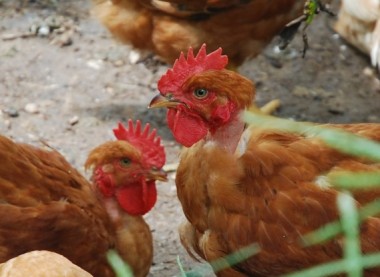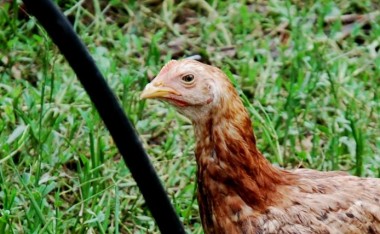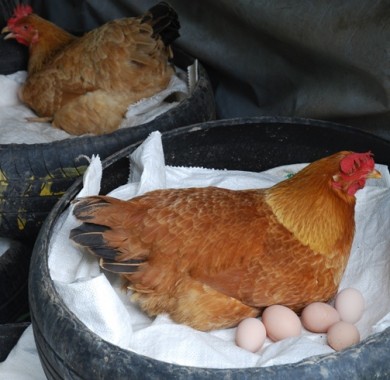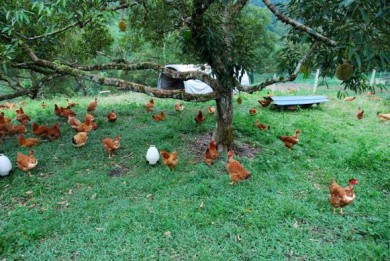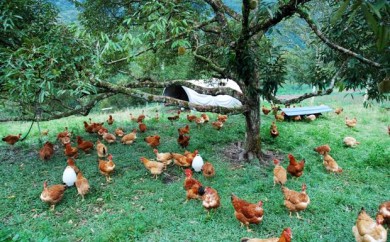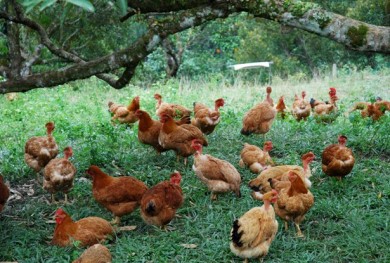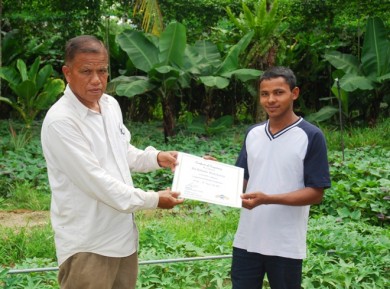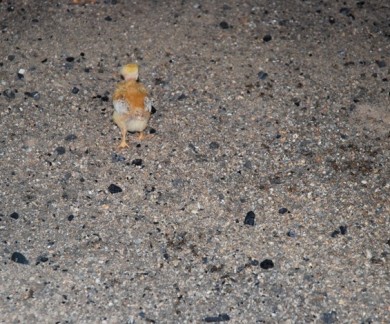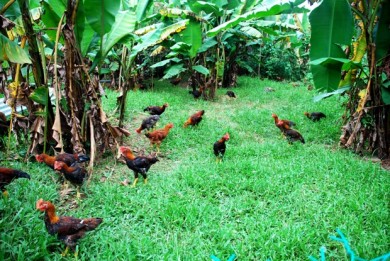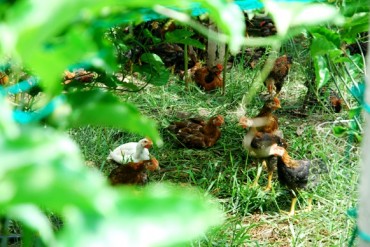Apr 16, 2013
Free-Range Egg Model for Rural Farmers
This is the free-range layer model we intend to implement as a social enterprise with rural low-income farmers. If they sell the eggs themselves at the Farmers’ Market, each egg should fetch rm1.00 each. We will supply them 200 pullets that are close to laying unlike what is happening now when the poor farmers are given day-olds and in no time, disease will wipe out all the birds.
At the very least, the farmers can expect an income of between rm2500 to rm3000.00 per month.
We will be starting with five farmers in Pahang.
13:50 Posted in Blog, Chickens, Nature Farming, Permaculture, Sustainable Farming | Permalink | Comments (1) | Tags: free range egg laying model, free range eggs malaysia, organic eggs malaysia
May 19, 2012
Eggs - What's That Wiggly Thingy?
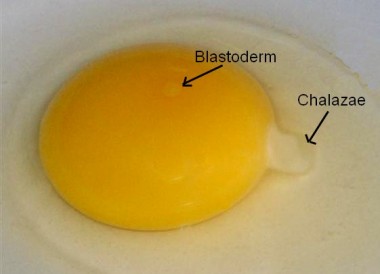
A store is no longer stocking our grassfed, free range eggs because a couple of their customers complaint about that 'wiggly thingy' found in our eggs, and that obvious round disc on the egg yolk.
Well, if we were the store owner, this is what we would say to the customer:
1. We try to give our hens as natural a life as possible. This includes plenty of space to roam, grass to eat, and surprise, surprise, a 'husband'. So, as is normal when wives and husbands get together, eggs get fertilised and babies are born. So that disc on the yolk is a fertilised germinal disc, or blastoderm. Unfertilised eggs will have just a speck. Fertilised eggs will have a disc. And we promise you, eating fertilised eggs will not make you more manly and sprout whiskers, nor will it make you pregnant, nor will it make your unborn baby develop 'chicken brainism', a brain disease of unknown origins.
2. And that wiggly thingy is the chalazae, made of the same material as the white of the egg and intended to hold the yolk in place. Chalazae is prominent in the freshest of eggs. It dissolves and disappears as the egg ages. So, dear customer, the eggs with absolutely no chalazae that you have been eating are clearly not fresh inspite of the words printed in bold on the label, Farm Fresh. 'Chicken Brainism' is a disease common amongst modern consumers and we have no idea where the disease comes from but we can assure you it does not come from eating fresh eggs from hens that are allowed to lead as natural a life as possible.
12:10 Posted in Blog, Chickens | Permalink | Comments (0) | Tags: organic eggs, free range eggs, blastoderm, chalazae
Apr 06, 2012
VRE - Public Health Threat?
Vancomycin Resistant Enterococci (VRE) is often indicative of antibiotic abuse. Farms that use sub-therapeutic antibiotic continuously may have animals that harbor VRE.
VRE have been found in many countries in poultry meat, pork, beef, milk and cultured fish.
VRE poses a potential public health threat.
In 2005, our country reported a case of Community-Acquired Infection (CAI) of VRE. The report is here.
The point of infection is speculative in the report, but it does raise the red flag in so far as the possibility of CAI of VRE is concerned, in our country. This means that the possibility of infection have now moved out from the hospital environment to the community.
In the light of the possibility of community acquired infection of VRE, responsible farmers must do self-monitoring and self-testing to prevent selling meats that are infected with VRE.
All our poultry are tested to be free from Salmonella Enteritidis and VRE before processing. Here’s the test results on VRE in our recent samples sent to the lab :
Click on table for close-up
VRE infection is especially dangerous for those who are immune-compromised, e.g. cancer patients, those with heart problems, kidney problems, etc.
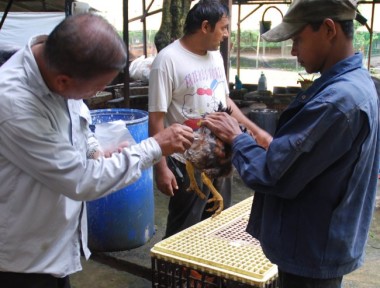
Farm manager Razaly taking a swab.
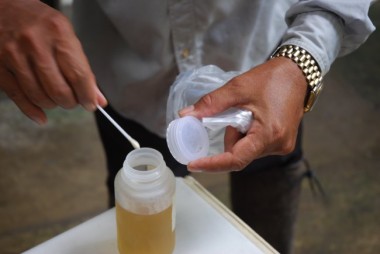
Preserving the samples in BP Water.
Testing samples from the farm is essential to ensure result integrity as samples from processed chickens may reflect cross contamination during handling.
16:52 Posted in Blog, Chickens | Permalink | Comments (0) | Tags: vre, se, salmonella enteritis, vancomycin resistant enterococci, antibiotic abuse
Mar 09, 2012
Round Eyes, 'Long' Eyes
If you have a few thousand chickens running around, how do you know if some disease is starting?
In antibiotic-free poultry raising, it is extremely important that we catch problems fast. By the time the chicken shows obvious signs, the disease is well advanced and mortality can be high.
One of the fastest way we know of, especially if we are relying on workers, is to go like this first thing in the morning:
Farmer: How’s the chickens in Field Number 10?
Worker: OK, they are eating and running around.
Farmer: Are the eyes round?
Round Eyes
Worker: Most have round eyes. Some have 'long' eyes.
'Long' Eyes
Farmer: Out of 10 chickens, how many round, how many long?
Worker: 8 round, 2 long.
Round Eyes, 'Long' Eyes
20% of your chickens are showing signs of problems. You best head over to the field fast to see what’s the problem. First make sure the ‘long’ eyes is not due to physical eye problems.
Then, sacrifice a few chickens and examine the internal organs. Once you have narrowed down the possible causes, take the necessary action.
11:06 Posted in Chickens, Nature Farming, Sustainable Farming | Permalink | Comments (0) | Tags: free-range poultry, organic chicken farming, necropsy, poultry disease identification, chicken diseases
Nov 23, 2011
Free Range Layers I
We recycle used tires as nests for our layers.
Here's a double decker. It can also be a triple decker, both sides, like an 'A' frame.
Hens selecting their nests for the evening lay; they can be fussy. Our flock size is 150 hens.
Sometimes several hens just want that particular nest!
Last one to lay!
This particular flock have 200 sq ft of grass field per hen. That's chicken heaven!
09:55 Posted in Chickens, Sustainable Farming | Permalink | Comments (1) | Tags: free range layers, organic eggs, grassfed eggs, used tires, used tire nests, uses for used tires
Oct 22, 2011
Warms The Heart...
Warms the heart to see our layers going about their business without a care the morning after that down pour. We grow them deliberately on a hill so that the grounds will dry faster after rain and to ensure a clean and dry environment for the eggs.
10:53 Posted in Blog, Chickens | Permalink | Comments (0) | Tags: egg laying chickens, free range layers, free range eggs, organic eggs, grass fed eggs, grassfed chickens
Oct 08, 2011
Raising Free Range Chickens - Necropsy & Disease Identification
Being able to perform necropsy of dead chickens and to identify diseases is crucial for the success of a chicken farm.
Delays in disease identification can lead to outbreaks resulting in high mortality and economic losses.
It is absolutely necessary for detail records to be kept from Day 0 until all the chickens are sold, for each batch. Detail records will enable us to analyse out trends and history, which together with the lesions in organs will help identify the many causes of poor weight gain, mortality, etc.
For example, trend analysis enabled us to identify a non-gumboro spiking mortality phenomenon in young chicks below two weeks old, which we ultimately traced to mosquitoes.
Dirgha Bahadur Tamang, from Nepal, has reached competency in necropsy and disease identification.
Dirgha receiving his certificates from Razaly, the farm director
We provide him with a 3 inch thick file of laminated pictures of the key clinical signs of various common chicken diseases. He uses the pictures as a reference and when he sees the start of infectious disease in culled chickens, he will raise the alarm for quick pre-emptive action.
Dirgha with his certificates and his file on common poultry diseases
We hope to be able to sponsor him for further studies to be a vet some time in the future.

Dirgha performing a necropsy on a young chick.
Oct 07, 2011
Spreading The Word II
Certificate in Biochar Production
Bal Bahadur Bishokarma, from Nepal, used to make charcoal for sale at his village using traditional pit methods. Since coming to our farm, he realizes that our methods are less wasteful and involves less physical work. He now knows the importance of planting trees for charcoal production rather than cutting down forest trees.
Here he is receiving his competency certificate from Razaly, the farm director.
At the farm, for each of the planted trees he cuts down for biochar (biochar is charcoal used for soil amendment generally using less 'dense' material) production, he has to plant five.
The tree of choice here at our farm is gliricidia sepium (for biochar) and acacia mangium (for charcoal). They are fast growing and hence are excellent carbon sequesters.
The resultant biochar has multiple uses at our farm. The main use is in the chicken litter to reduce free gaseous ammonia which can cause inflammation in the respiratory tracts of young chicks.
We have done tests at our farm to see if soil amended with biochar versus unamended soil has a difference in productivity. The results show no significant difference. The reason would seem to be that our soil is already very rich in microbial population and was never intensely cultivated. Perhaps in areas with less fertile soil and subject to repeated cultivation, biochar amendment may produce results as per the writings of many advocates.
At the farm, our biochar production is to reduce our carbon footprint by sequestering carbon (CO2) from our animals using fast growing trees. These trees are then used to produce biochar which are used in our poultry and aquaculture operations, and to filter discharge from our farm.
When Bal returns to Nepal, hopefully, he can make a living out of producing biochar and charcoal on a sustainable basis.
15:35 Posted in Biochar, Blog, Chickens | Permalink | Comments (0) | Tags: biochar, charcoal, ammonia reduction in chicken litter, pyrolysis, gliricidia sepium, acacia mangium, biochar production
Sep 10, 2011
Grass Fed Chickens - Some Basic Considerations
Choosing the right breed is important.
In the West, Cornish Crosses ( white feathered broilers) are free-ranged and pastured (grass fed).
In Malaysia, that's not possible. They will die from heat-stroke.
Many in Malaysia choose the Kabir ( a Sasso-type chicken) to free-range. Like the Cornish Crosses, the Kabir too, have very high metabolic rates and they will easily succumb to our mid-day sun without adequate shade and drinking water that is cooler than ambient.
Also, with their high metabolic rates, they need continuous feeding of high calorie feed. This defeats the purpose of pasturing as they will just sit around eating the feed pellets rather than forage. The omega 6: omega 3 ratio will be high, as they eat mainly the grain-based pellets. Health-wise to the consumer, it makes no difference whether these chickens are raised in a house or free-ranged. They will not and cannot be successfully grass fed. True grass fed chickens can never reach 2.5kg and above in weight. To grow to that size, they need a high calorie feed from grains and fats, which grasses cannot provide ( chickens are not cows and goats and cannot absorb the nutrients in grasses adequately like ruminants can).
Our tests have shown that Cornish Crosses and Kabir (Sasso) will have omega 6: omega 3 ratios as high as 40:1 and above if fed corn-based pellets ad-libitum even though raised on grass fields.
At our farm, we use mainly crosses from our traditional ayam kampung.
Ayam kampung will range whereas Cornish Crosses and Kabir will sit around
Providing sufficient space for the chickens to roam and for the land to recover fast is crucial. Our experience shows that we need a minimum of 25 sq ft of free roaming land for each chicken (factory farms provide 0.75 sq ft per chicken). Depending on the local conditions, this requirement may go up to as high as 50 sq ft of land per chicken. With sufficient space, the grasses can recover during the time the chickens are in the fields as we move them from one end of the field to the other.
So, two factors are involved here. One is the chickens must be moved along, and two the local soil conditions must allow the grasses to recover within the time that the chickens are in the field. In Malaysia we are lucky that our fields are easily 20 times more productive in terms of grass growth than many Western countries. The soil at our farm can count up to 60 to 100 earthworms per cubic feet. That's something Western farmers will die for!
Here are short clips taken from our hand phone. Note that the chickens are already market size and yet the fields are still green. In many farms when the chickens are at market size, the fields will be bare and smelly - that's perhaps one of the tests you as consumers can use to determine whether the chickens are truly grassfed.
Note how well these chickens make use of the space given to them by foraging and eating the grasses and plants.
10:13 Posted in Blog, Chickens | Permalink | Comments (0) | Tags: grass fed chicken, pastured chicken, free-range chicken, organic chicken, omega 6: omega 3 ratio, omega 3, dha, ayam kampung, cornish crosses, kabir, sasso
Aug 03, 2011
Free Range Chicken - Natural Sun-Shading I
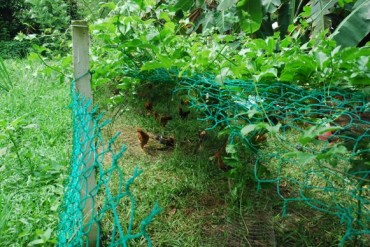
This Ramadan sure is hot. For the watermelon seller, bad sales surely is not his lot. The chickens listlessly loll. Under the markisa shelters. Aren't we glad we had tolled. These lovely markisa all to enjoy.
Yesterday was 40 celcius. Hot enough for these chickens to drop dead from heat stroke. And we are talking about ayam kampung, tough as nails!
Natural sun shading used in the farm includes these passion-fruit vines and clumps of big-leafed pisang sematu. Remember, bare earth retains and reflects heat. Bare earth patches can be 5 celcius higher than grass covered patches. And all water-lines MUST be protected from the sun.
A friend of mine is running a closed-house farm. He is cursing day-and-night over his energy bills.
Selamat berpuasa.
10:20 Posted in Chickens, Permaculture | Permalink | Comments (1) | Tags: permaculture, free range chickens, sun shading, passion fruit, markisa, ramadan









